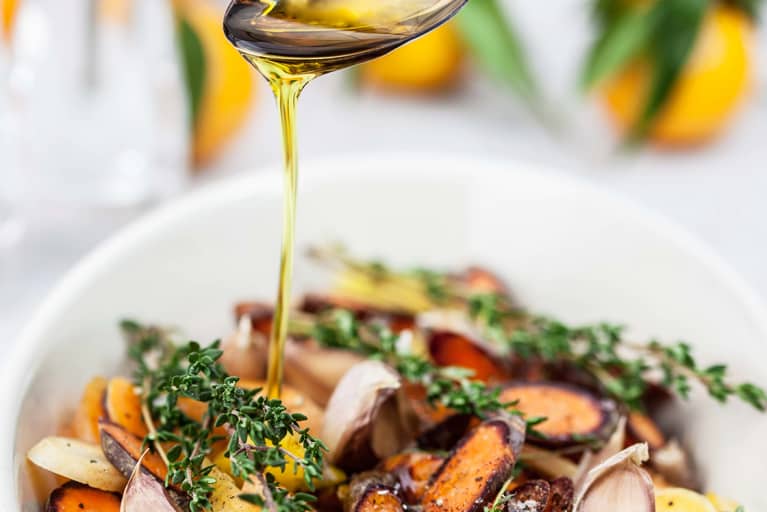Health Experts Want You To Be Very Cautious Of This Popular Cooking Oil
Not every bottle is created equal.


Our editors have independently chosen the products listed on this page. If you purchase something mentioned in this article, we may earn a small commission.
Sunflower oil may not be a staple in your household, but you can find it alongside other culinary oils in most grocery stores, often marketed as a neutral-tasting, high-heat cooking option. It has also become an increasingly common ingredient in a variety of packaged foods (from chips to granola to non-dairy ice cream) as well as a popular frying oil in restaurants.
But how healthy is sunflower oil, and does it deserve a spot in your pantry? Turns out, it’s not a simple yes or no. Sunflower oil is available in a variety of forms—with different fatty acid profiles and levels of refinement—and these come with different benefits and drawbacks. Here’s everything you need to know to make an informed choice.
Sunflower oil is an edible oil derived from sunflower seeds. While sunflowers originated in North America (their seeds were eaten and squeezed for their oil by Native Americans), sunflower oil wasn’t commercially produced until it arrived in Eastern Europe in the 1800s. There, it was used as a substitute for butter and lard, which were prohibited by the Russian Orthodox Church during Lent. Until recently, Ukraine and Russia were the top two producers of sunflower oil, accounting for more than 50% of the world’s sunflower oil production. However, the war in Ukraine has destroyed wide swaths of farmland and prevented sunflower harvests, which has reduced access to sunflower oil across the globe.
Functional Nutrition Training
A cutting-edge nutrition deep dive taught by the world’s foremost health & wellness experts

All varieties of sunflower oil contain around 14 grams of total fat, minimal saturated fat, and a good amount of vitamin E. Beyond that, however, things can look pretty different depending on the type of sunflower oil. Why? Sunflowers have undergone selective breeding to yield seeds with different fatty acid profiles, which are then used to make sunflower oils with different fatty acid profiles—and they’re not all created equal.
There are three main types of sunflower oil available for home cooking that contain varying proportions of oleic acid (a type of monounsaturated fatty acid, or MUFA) and linoleic acid (an omega-6 polyunsaturated fatty acid, or PUFA). Sunflower oil isn’t always clearly labeled using the terms below, but you can look at the nutrition facts panel to see a breakdown of each fat.
Why does the fatty acid profile matter? MUFAs are much more stable fats compared to PUFAs—so the proportion of these fats present in a sunflower oil will impact its stability, or ability to resist oxidative damage during refining and cooking. Oil that experiences significant oxidative damage accumulates a variety of unhealthy compounds that, in turn, drive unhealthy processes such as oxidative stress and inflammation, according to physician Cate Shanahan, M.D., a respected authority on vegetable and seed oils and author of The Fatburn Fix.
Aside from its fatty acid profile, sunflower oil’s level of refinement can differ, too. While unrefined varieties are made by pressing sunflower seeds to extract the oil then gently separating (or lightly filtering) out the solids from the liquid oil without the use of chemicals or heat, others are highly refined and require the use of chemical solvents like hexane to draw the oil from the seeds along with high heat and pressure to eliminate impurities that may contribute to unwanted flavors or a lower smoke point. This refinement can cause significant oxidative damage to fat molecules, per Shanahan, not to mention a reduction in beneficial phytochemicals and nutrients.
So, it’s easy to see how the health benefits and potential drawbacks of sunflower oil are highly dependent on both its fatty acid composition and how it was processed. Unless specified, much of the sunflower oil sold and used in packaged goods is both highly refined and of the high-linoleic (i.e. high-PUFA) variety—which is a problematic combination. Better-for-you options do exist, but they’re still not your healthiest cooking oil choice.
Potential health benefits of sunflower oil.
One undisputed fact is that sunflower oil is a good source of vitamin E. Not all sunflower oil lists its vitamin E content on the nutrition facts panel, but some may contain as much as 40% of the recommended daily allowance (RDA). Vitamin E is a fat-soluble vitamin that functions as an antioxidant and plays a role in metabolic processes such as cell signaling, hormone balance, and gene expression, according to registered dietitian Amy Gonzalez, R.D., FNTP, CLT. It’s also the most abundant fat-soluble antioxidant in the skin, where it helps counter UV damage and skin inflammation, and supports wound healing.
“In mbg’s ultimate multivitamin+, we chose to leverage the amazing sunflower, specifically the native oil of the sunflower seeds, to source our vitamin E in its most bioavailable and bioactive form, d-alpha-tocopherol,” says Ashley Jordan Ferira, Ph.D., RDN, mbg's vice president of scientific affairs. “While there are other high-quality plant oil sources of vitamin E, we wanted to elevate and celebrate as many premium botanicals in this plant-centric vegan multi as possible.”
Sunflower oil is also touted as a heart-healthy oil due to its low levels of saturated fats and high levels of unsaturated fats. However, research suggests this may only be true for high-oleic sunflower oil, as opposed to mid-oleic and high-linoleic varieties. “Oleic acid is a famously heart-healthy constituent of a Mediterranean dietary pattern and lifestyle,” says Ferira.
Several studies have found that consuming monounsaturated fats such as oleic acid may help optimize cholesterol levels. In one study, people with elevated blood lipids who added high-oleic sunflower oil to their diet for eight weeks experienced an elevation in HDL (“good”) cholesterol, while another study found that people who added high-oleic sunflower oil to their diet for 10 weeks has lower levels of LDL (“bad”) cholesterol and triglycerides than people eating a comparable amount of saturated fat. Findings like this have prompted the Food & Drug Administration (FDA) to approve a qualified health claim that consuming 1.5 tablespoons of oleic acid-rich oils per day in place of saturated fats may reduce risk of coronary heart disease.
You can also use sunflower oil topically—and you may see it as an ingredient on your body or facial oil. For this purpose, you may actually want to use a high-linoleic variety of sunflower oil, which has been shown to improve hydration and skin barrier integrity better than several other oils, including olive oil. Sunflower oil may also help rebalance acne-prone skin, as research suggests people with acne tend to produce sebum with diminished linoleic acid content.
Potential downsides of sunflower oil.
A lot can go wrong with sunflower oil—“depending on how it’s processed and its fatty acid profile, it can be extremely unhealthy and contribute to significant metabolic dysfunction,” says Shanahan. As mentioned above, you really want to avoid refined sunflower oil varieties that are also high in linoleic acid, an omega-6 PUFA that is quite unstable.
There’s nothing inherently wrong with omega-6 PUFAs, but the damage that occurs to these fats when exposed to high temperatures during refining, and then again during cooking, is a big problem. “When these unstable PUFAs encounter the high heat, they oxidize and break down chemically to produce dangerous new molecules such as aldehydes, 4-hydroxynonenal, cyclic amines, toxic alcohols, and toxic ketones,” says Shanahan. When consumed, this collection of compounds can drive oxidative stress and inflammation in the body and contribute to a range of inflammatory conditions, from joint pain to acne to gut problems to a variety of chronic diseases.
But if heating high-PUFA oils like sunflower oil can create such a nasty cocktail of compounds, you may be wondering why it’s marketed as having a high smoke point. Contrary to popular belief, an oil’s smoke point doesn’t always guarantee stability under heat. In fact, various studies (like this one) show that after repeated frying sessions, a higher level of harmful byproducts are produced in high-linoleic oils such as sunflower oil (smoke point 450 degrees Fahrenheit) than in high-oleic oils such as olive oil (smoke point 350 to 470 F). If you really want to cook with sunflower oil, high-oleic varieties are a more stable choice.
Finally, if you eat a lot of PUFA-rich oils such as sunflower oil (and other common vegetable and seed oils), they can end up stored in your body fat. The problem there, explains Shanahan, is that when your body later burns these fats for fuel, they break down—yet again—into the same dangerous compounds mentioned above, further driving inflammation and overall metabolic dysfunction. Keep in mind, you may unintentionally be ingesting these oils when you consume packaged foods—so read those labels and aim to consume more whole foods in general.
Uses & which types to buy.
Sunflower oil doesn’t necessarily offer anything that unique—other than a hefty dose of vitamin E. So you may be better off going with something like olive oil or avocado oil, both of which Shanahan prefers to sunflower oil. These oils are naturally rich in stable MUFAs (predominantly oleic acid), readily accessible, and contain a range of beneficial phytochemicals and nutrients.
But if you’re set on trying sunflower oil, refer to the better-for-you suggestions below, and keep in mind that not all varieties are suitable for all applications.
High-oleic sunflower oil that’s cold-pressed.
These cold-pressed oils are slowly expeller pressed and unrefined so they never exceed 120 degrees Fahrenheit, which helps them retain maximum flavor and nutrition; and their high MUFA content means they’re relatively stable when heated. You’ll retain the most nutrition and flavor if you use them for light cooking techniques such as sautéing or as a finishing oil. These aren’t widely available and they’re typically sold by smaller, boutique brands. Store them out of direct sunlight, as you would an extra virgin olive oil.
High-oleic sunflower oil that’s expeller-pressed.
These oils have been manually extracted without chemical solvents, but they have most likely been refined using heat under a vacuum, which reduces levels of certain nutrients. (Keep in mind, organic implies that the oil is at least expeller-pressed.) Because these oils are predominantly composed of MUFAs, however, the level of oxidative damage they sustain is far less than with higher PUFA varieties. These generally have a mild to neutral flavor, hold up relatively well to higher temperature cooking, and are becoming more widely available.
Mid-oleic or high-linoleic sunflower oil that’s cold-pressed.
These cold-pressed oils are slowly expeller pressed and unrefined so they never exceed 120 degrees Fahrenheit, which helps them retain maximum flavor and nutrition; but their higher PUFA content makes them less stable and more prone to oxidation, so they should only be used in raw applications or as a finishing oil. Their high linoleic acid content makes them a good choice for topical skin use. These should be stored in the refrigerator to maintain freshness.
Try this: Flora Certified Organic Sunflower Oil, Cold-Pressed & Unrefined
Clearly, there’s nothing straightforward about sunflower oil. Its potential health benefits and drawbacks are highly dependent on its fatty acid composition and level of refinement, coupled with the way you’re using it. While it’s true that much of the sunflower oil on the market is highly refined and has a fatty acid profile that makes it prone to oxidation (and thus, prone to causing health problems), healthier options do exist. And while sunflower oil will never top a good EVOO or avocado oil in terms of nutrition, it does make a superior topical skin treatment.
https://www.mindbodygreen.com/articles/sunflower-oil

 UsenB
UsenB 






























.jpg)